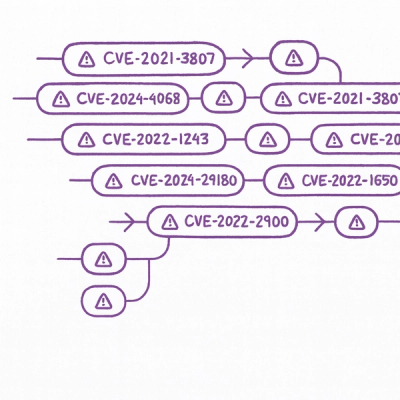
Security News
New Website “Is It Really FOSS?” Tracks Transparency in Open Source Distribution Models
A new site reviews software projects to reveal if they’re truly FOSS, making complex licensing and distribution models easy to understand.
Jade is a very popular templating engine for Node.js. This gem gives you ability to easily use Jade templates for both server and client side in your Rails project.
On the client-side your templates should be used with Rails' JST engine. On the server side, you can render your Jade templates as Rails views (similar to how you'd render ERB or HAML templates).
Lets assume you have a users controller app/controllers/users_controller.rb which in turn renders a list of users.
We'd like to share that view between the client and the server.
class UsersController < ApplicationController
def index
@users = User.all
respond_to do |format|
format.html
end
end
end
To share our template between client and server, we need to place it under app/assets/javascripts for Sprockets' JST engine.
Lets create a views directory for our shared templates app/assets/javascripts/views and add our template there, following Rails' naming convensions.
The full template path should look like this: app/assets/javascripts/views/users/index.jst.jade
The most significant differences between using standard server-side Ruby-based engines like ERB or HAML and using Jader are:
@usersOur template code should look like this:
ul.users
each user in users
li.user= user.name
Note that rendering this template server-side, will be done inside your application's layout. You can write your views layout file in ERB / HAML
and the call to =yield will render your Jade template above.
Since Rails doesn't expect server-side templates to live under app/assets we need to add our client-side views path to Rails views lookup path.
Assuming we have an initializer app/config/initializers/jader.rb we can add our client-side views directory like this:
Jader.configure do |config|
# make your client-side views directory discoverable to Rails
config.views_path = Rails.root.join('app','assets','javascripts','views')
end
Internally, this adds a before_filter to ApplicationController::Base that prepends the provided path to ActionView::Context .
To render the same template from the client, we need to fetch our users list from the server and then call our JST template with that list.
First, lets change our controller to return a JSON formatted list of users when called from the client:
class UsersController < ApplicationController
def index
@users = User.all
respond_to do |format|
format.html
format.json {
render :json => @users.to_jade
}
end
end
end
Note the call to to_jade on the @users collection. This ensures our users are properly serialized for use inside our template.
See the Serialization section below for more details.
In our application.js file lets write the following:
//= require jade/runtime
//= require views/users/index
$.getJSON('/users', function(users){
$('body').html(JST['views/users/index']({users:users}));
});
To help Jader access Ruby and Rails variables inside the template, we need to employ some sort of JSON serializing before passing these variables to the template. On the server-side, this happens automagically before the template is rendered.
Internally, Jader will try to call the to_jade method on each instance variable that's passed to the template. Ruby's Hash, Array and Object classes have been extended
to support this functionality. Arrays and Hashes will attempt to call the to_jade method on their members when to_jade is invoked on their instances. For
other collection-like variables, the to_jade method will only be invoked if they respond to a to_a method. This allows ActiveModel / ActiveRecord instance variables to
automatically serialize their members before rendering.
Jader does not assume your Rails models should be serialized by default. Instead, it expects you to enable serializing on desired models explicitly.
To enable this behaviour, consider the following example:
class User < ActiveRecord::Base
include Jader::Serialize
jade_serializable :name, :email, :favorites, :merge => false
end
The call to include Jader::Serialize mixes Jader::Serializer capabilities into our model class.
We can then tell the serializer which attributes we'd like to serialize, and how we'd like the serialization to work.
By default, calling jade_serializable with no arguments will serialize all your model attributes. Lets look at two examples:
Consider the following code:
# define our model
class User < ActiveRecord::Base
include Jader::Serialize
jade_serializable
end
# access in controller
class UsersController < ApplicationController
def index
@users = User.all
@users.to_jade # => all available user attributes (users table columns) will be serialized
end
def active
@users = User.where('active = 1').select('name, email')
@users.to_jade # => only name and email attributes are serialized
end
end
For better control over which attributes are serialized, and when serializing model relationships, we can tell the serializer which attributes should always be serialized, and whether we'd like these attributes to be merged with the default attributes or not.
Consider the following code:
# define our models
class Favorite < ActiveRecord::Base
include Jader::Serialize
jade_serializable
belongs_to :user
end
class User < ActiveRecord::Base
include Jader::Serialize
jade_serializable :favorites, :merge => true
has_many :favorites
end
# access in controller
class UsersController < ApplicationController
def active
@users = User.where('active = 1').select('name, email')
@users.to_jade # => only name, email and favorites attributes are serialized
end
end
In the above, we defined serialization for the User model to include the :favorites attribute, which is available because of the has_many relationship
to the Favorite model. Additionally, we specified that serialization should merge model default attributes with the specified attributes, by setting :merge => true .
This will result in merging self.attributes and self.favorites on any instance of the User model when calling the to_jade method on it.
To only serialize the specified attributes, call jade_serializable with :merge => false .
Invokation format for jade_serializable is:
jade_serializable :attr1, :attr2, :attr3 ...., :merge => true/false
By default, jade_serializable will operate with :merge => true and merge instnace attributes with specified attributes.
Jade has built in support for template mixins. Jader allows you to define and share mixins inside your templates.
Following Rails helpers conventions, your Jade mixins can be defined either as application-level mixins or as controller-level mixins.
Assuming we have a users controller, we can add mixins by creating a mixins folder under app/assets/javascripts and adding:
app/assets/javascripts/helpers/application_mixins.jadeapp/assets/javascripts/helpers/users_mixins.jadeMixins that are defined inside application_mixins.jade will be available in all templates. This is a perfect place for example to add a pagination mixin.
Controller-level mixins are defined inside CONTROLLER_NAME_mixins.jade and are available only inside the relevant controller. Since the
client-side has no notion of which controller is currently being rendered, we need to strictly follow Rails naming conventions as follows:
UsersController we will have app/assets/javascripts/views/usersmixins/users_mixins.jade will be available for views inside views/users folderTo enable Jader's mixins capabilities we need to configure Jader and tell it where to look for mixins files:
Jader.configure do |config|
config.mixins_path = Rails.root.join('app','assets','javascripts','mixins')
end
On the client-side, Jader will add the mixins code into your Jade JST template. This can potentially increase your client-side file size dramatically. Since application-level mixins are included in each and every template, please be sure to keep them to a bare minimum.
Often we'll have additional Javascript that is included client-side and adds more functionality to our client-side application. Two such examples could be
using I18n.js for internationalization, or Date.js for better date handling.
Since our server-side templates cannot access this code, we need to figure out a way to share arbitrary Javascript from our client in the server.
This is where inclusions come in.
We can tell Jader to add arbitrary pieces of raw Javascript to the server-side rendering context before evaluating our template like so:
Jader.configure do |config|
config.includes << IO.read(Rails.root.join('app','assets','javascripts','includes','util.js'))
end
Jader.configuration.includes is an array that accepts raw Javascript strings that are, in turn, passed to the server-side template evaluation context.
To give a more pragmatic example of using Jader inclusions, lets try using I18n.js on both server and client.
For the sake of this example, we assume gem 'i18n-js' is installed in our application.
Our application.js file will then include:
//= require i18n
//= require i18n/translations
The first require is made available via i18n-js vendorized assets while the second require is a translations file inside our app/assets/javascripts/i18n folder.
To enable I18n support when rendering templates on the server, we configure Jader as follows:
Jader.configure do |config|
# wait for assets to be ready
Rails.application.config.after_initialize do
# inject assets source into Jader's includes array
config.includes << Rails.application.assets['i18n'].source
config.includes << Rails.application.assets['i18n/translations'].source
config.includes << "I18n.defaultLocale = 'en'; I18n.locale = 'en';"
end
end
Its recommended to configure Jader inside a Rails initializer so that configuration is defined at boot time.
Assuming we have an initializer app/config/initializers/jader.rb it should include:
Jader.configure do |config|
config.mixins_path = Rails.root.join('app','assets','javascripts','mixins')
# make your client-side views directory discoverable to Rails
config.views_path = Rails.root.join('app','assets','javascripts','views')
# Use some javascript from a file that's not available in the asset pipeline
config.includes << IO.read(Rails.root.join('app','assets','javascripts','includes','util.js'))
# In Rails 3 applications, prepend views_path using a controller before filter.
# This is set to false by default
config.prepend_view_path = true
# wait for assets to be ready
Rails.application.config.after_initialize do
# include javascripts available only from asset pipeline
config.includes << Rails.application.assets['util'].source
end
end
In case your Rails asset pipeline is configured not to load the entire Rails environment when calling rake assets:precompile, you should include Jader's configuration initalizer in your Rakefile.
Simply add require File.expand_path('../config/initializers/jader', __FILE__) before require File.expand_path('../config/application', __FILE__) in your Rakefile, and ensure Jader is properly configured when your assets are precompiled
Jader is built upon the wonderful work of Boris Staal and draws heavily from:
Boris Staal's Jade Rubygem was developed as a successor to tilt-jade to improve following:

Copyright (c) 2012 Zohar Arad zohar@zohararad.com
Permission is hereby granted, free of charge, to any person obtaining a copy of this software and associated documentation files (the "Software"), to deal in the Software without restriction, including without limitation the rights to use, copy, modify, merge, publish, distribute, sublicense, and/or sell copies of the Software, and to permit persons to whom the Software is furnished to do so, subject to the following conditions:
The above copyright notice and this permission notice shall be included in all copies or substantial portions of the Software.
THE SOFTWARE IS PROVIDED "AS IS", WITHOUT WARRANTY OF ANY KIND, EXPRESS OR IMPLIED, INCLUDING BUT NOT LIMITED TO THE WARRANTIES OF MERCHANTABILITY, FITNESS FOR A PARTICULAR PURPOSE AND NONINFRINGEMENT. IN NO EVENT SHALL THE AUTHORS OR COPYRIGHT HOLDERS BE LIABLE FOR ANY CLAIM, DAMAGES OR OTHER LIABILITY, WHETHER IN AN ACTION OF CONTRACT, TORT OR OTHERWISE, ARISING FROM, OUT OF OR IN CONNECTION WITH THE SOFTWARE OR THE USE OR OTHER DEALINGS IN THE SOFTWARE.
FAQs
Unknown package
We found that jader demonstrated a not healthy version release cadence and project activity because the last version was released a year ago. It has 2 open source maintainers collaborating on the project.
Did you know?

Socket for GitHub automatically highlights issues in each pull request and monitors the health of all your open source dependencies. Discover the contents of your packages and block harmful activity before you install or update your dependencies.

Security News
A new site reviews software projects to reveal if they’re truly FOSS, making complex licensing and distribution models easy to understand.

Security News
Astral unveils pyx, a Python-native package registry in beta, designed to speed installs, enhance security, and integrate deeply with uv.

Security News
The Latio podcast explores how static and runtime reachability help teams prioritize exploitable vulnerabilities and streamline AppSec workflows.